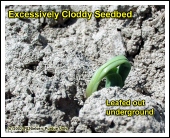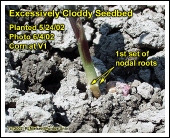

![]() loddy soil conditions are a natural outcome of working
ground that is “on the wet side”. Heaven knows that Indiana has had
its fair share of wet fields during the 2002 planting season that have cloned
an impressive number of cloddy seedbeds.
loddy soil conditions are a natural outcome of working
ground that is “on the wet side”. Heaven knows that Indiana has had
its fair share of wet fields during the 2002 planting season that have cloned
an impressive number of cloddy seedbeds.
One of the consequences of cloddy seedbeds is poor seed-to-soil contact that results in unsuccessful or uneven germination of the planted kernels. Another consequence is the physical restriction that clods impose on the emerging coleoptile that often results in the leaves emerging from the coleoptile underground before the coleoptile has reached the soil surface. A third consequence, and one that is often overlooked, is the potential limitation imposed by the dry clod environment on the elongation and successful establishment of the initial sets of nodal roots.
Interestingly, the existence of massive numbers of clods does not always result in poor or uneven germination. This is particularly true if the clod seedbed environment remains moist enough to allow for water imbibition and germination of the seed or if timely rainfall occurs following planting that “melts” the clods and improves seed-to-soil contact.
 |
 |
The ability of the clods to physically restrict the emergence of the coleoptile depends on their size and weight plus the degree to which the clods have “cemented” together with subsequent rains. Technically, the clods do not “cause” the seedling to leaf out underground. Rather the effect is indirect as a result of the restriction of the coleoptile emergence. The developing leaves inside the coleoptile rupture through the coleoptile relatively “on schedule”. It’s just that if the coleoptile emergence through the soil surface has been delayed, the “normal” leafing out occurs below ground rather than above ground. Ditto for the effects of a severely crusted soil surface on corn emergence. A technicality to be sure, but this knowledge may someday win you a trivia contest.
 |
 |
 |
The mid-summer heat and strong drying winds of the first few days of June rapidly dried out the clod seedbed environment in some fields planted in late May at a point in time when the first sets of nodal roots were beginning to elongate. Such fields that did not receive subsequent rainfall from the storms that went through the state on June 4-6 are at risk of developing what is often termed “floppy” corn syndrome.
This rootless condition develops whenever the initial few sets of nodal roots begin their development in a severely dry environment. In some fields, this severely dry environment is represented by the existence of several inches of dry clods at the surface.
 |
 |
During their initial elongation from the stalk nodes, nodal roots are susceptible to desiccation of their root tips under very dry conditions. If the young root tip dries out, that root’s growing point dies and the entire young nodal root stops development. Failure of successive sets of nodal roots to develop eventually leads to a rootless condition that either results in seedling death or the survival of plants to a point where they simply “flop over” for lack of support and then die.
 |
 |
 |
When clods are the cause of the dry rooting environment, there is little one can do to ameliorate the situation. Row cultivation will simply toss the clods around, knocking over or burying plants in the process. The only respite for a clod-caused “floppy” corn problem is the occurrence of a good soaking rain to “melt” the clods down and provide a better root development environment.
“May the Force be with you……”
 For other
information about corn, take a look at the Corn Growers Guidebook on the World
Wide Web at http://www.kingcorn.org
For other
information about corn, take a look at the Corn Growers Guidebook on the World
Wide Web at http://www.kingcorn.org